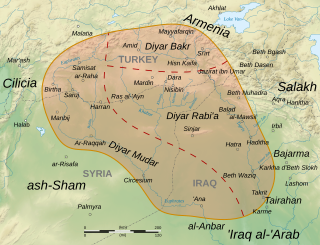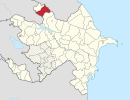
Abu Mansur Muhammad ibn Ahmad al-Mu'tadid, usually known simply by his regnal title al-Qahir bi'llah, was the 19th Caliph of the Abbasid Caliphate from 932 to 934. He was born 286 AH and died 339 AH.

The Encyclopaedia of Islam (EI) is an encyclopaedia of the academic discipline of Islamic studies published by Brill. It is considered to be the standard reference work in the field of Islamic studies. The first edition was published in 1913–1938, the second in 1954–2005, and the third was begun in 2007.
Shams al-Din Muhammad ibn Mahmud Shahrazuri was a 13th-century Muslim physician, historian and philosopher. He was of Kurdish origin. It appears that he was alive in AD 1288. However, it is also said that he died in the same year.
Ikhshid was the princely title of the Iranian rulers of Soghdia and the Ferghana Valley in Transoxiana during the pre-Islamic and early Islamic periods.
Beylerbey or Beylerbeyi was a high rank in the western Islamic world in the late Middle Ages and early modern period, from the Seljuks of Rum and the Ilkhanids to Safavid Persia and the Ottoman Empire. Initially designating a commander-in-chief, it eventually came to be held by senior provincial governors. In Ottoman usage, where the rank survived the longest, it designated the governors-general of some of the largest and most important provinces, although in later centuries it became devalued into a mere honorific title. Its equivalents in Arabic were amir al-umara, and in Persian, mir-i miran.

The Kapi Agha, formally called the Agha of the Gate of Felicity, was the head of the eunuch servants of the Ottoman Seraglio until the late 16th century, when this post was taken over by the Kizlar Agha. In juxtaposition with the latter office, also known as the Chief Black Eunuch as its holders were drawn from Black African slaves, the Kapi Agha is also known as the Chief White Eunuch.
Shaykh al-Islām was used in the classical era as an honorific title for outstanding scholars of the Islamic sciences. It first emerged in Khurasan towards the end of the 4th Islamic century. In the central and western lands of Islam, it was an informal title given to jurists whose fatwas were particularly influential, while in the east it came to be conferred by rulers to ulama who played various official roles but were not generally muftis. Sometimes, as in the case of Ibn Taymiyya, the use of the title was subject to controversy. In the Ottoman Empire, starting from the early modern era, the title came to designate the chief mufti, who oversaw a hierarchy of state-appointed ulama. The Ottoman Shaykh al-Islam performed a number of functions, including advising the sultan on religious matters, legitimizing government policies, and appointing judges. Modern times have seen the role of chief mufti carried out by Grand Muftis appointed or elected in a variety of ways.
Shihab al-Din Abu'l-Abbas Ahmad ibn Muhammad ibn Abu Bakr al-Qastallani al-Qutaybi al-Shafi'i, also known as Al-Qastallani was a Sunni Islamic scholar who specialized in hadith and theology. He owed his literary fame mainly to his exhaustive commentary on the Sahih al-Bukhari entitled Irshad al-Sari fi Sharh al-Bukhari.
Qays ʿAylān, often referred to simply as Qays were an Arab tribal confederation that branched from the Mudhar section of the Adnanites. The tribe does not appear to have functioned as a unit in the pre-Islamic era. However, by the early Umayyad, its constituent tribes consolidated into one of the main tribo-political factions of the caliphate.

Enderûn was the term used in the Ottoman Empire to designate the "Interior Service" of the Imperial Court, concerned with the private service of the Ottoman Sultans, as opposed to the state-administrative "Exterior Service" (Birûn). Its name derives from the location of the Sultan's apartments in the inner courts of the Topkapi Palace; its head was the Kapi Agha.
Roger Savory is a British-born Professor Emeritus at the University of Toronto who is an Iranologist and specialist on the Safavids. His numerous writings on Safavid political, military history, administration, bureaucracy, and diplomacy-translated into several language have had a great impact in understanding this period.
Muhammad bin Ali Rawandi, was a Persian historian who wrote the Rahat al-sudur wa ayat al-surur during the fall of the Great Seljuk Empire and the subsequent invasion by the Kharwarzmian empire.

Diyār Mudar is the medieval Arabic name of the westernmost of the three provinces of al-Jazira, the other two being Diyar Bakr and Diyar Rabi'a. According to al-Baladhuri, all three provinces were named after the main Arab tribes that were settled there by Mu'awiya I in the course of the early Muslim conquests of the 7th century. The Diyar Mudar was settled by the Mudar tribe.
Harthama ibn A'yan was a Khurasan-born general and governor of the early Abbasid Caliphate, serving under the caliphs al-Hadi, Harun al-Rashid and al-Ma'mun. He played an important role in the victory of al-Ma'mun in the Abbasid civil war, but was executed at his orders when he protested against the power of the Sahlid family that dominated his court.
Abuʾl-Ṣaqr Ismāʿīl ibn Bulbul (844/5–891) was a prominent official of the Abbasid Caliphate during the reign of al-Mu'tamid, serving as vizier of the Caliphate from 878 to 892.
The Sanjak of Nakşa Berre or Naxos was a second-level Ottoman province encompassing the central and southern Cyclades islands, and named after the two largest islands of Naxos and Paros. The sanjak encompassed the territory of the former Duchy of Naxos, which had been tributary to the Ottomans since 1537, but was not formally incorporated into the Empire until after 1579, when the last Duke, Joseph Nasi, was executed. The sanjak formed part of the Eyalet of the Archipelago at least by 1600, but is no longer attested after the late 18th century. Aside from the sanjakbey at Naxos, two other beys, at Milos and Santorini, are recorded in 1629. With the outbreak of the Greek War of Independence in 1821, the islands came under Greek control.
Karramiyya is a sect in Islam which flourished in the central and eastern parts of the Islamic worlds, and especially in the Iranian regions, from the 9th century until the Mongol invasions in the 13th century.
Abu Ishaq al-Isfara'ini was a medieval Sunni Islamic theologian, Shafi'i jurist, legal theoretician and commentator on the Qur'an. al-Isfara'ini's scholarship was focused on the sciences of Aqidah, Hadith and Fiqh. He was along with Ibn Furak the chief propagator of Sunni Ash'ari theology in Nishapur at the turn of the 5th Islamic century.

The Silahdar Agha was a palace office of the Ottoman Empire, denoting the principal page of the Ottoman Sultan. As such its holders were persons of great influence, and provided many senior officials and even Grand Viziers.
The Baqliyya or Būrāniyya were a subgroup of the Qarmatians that was active in southern Iraq in the early 10th century.









